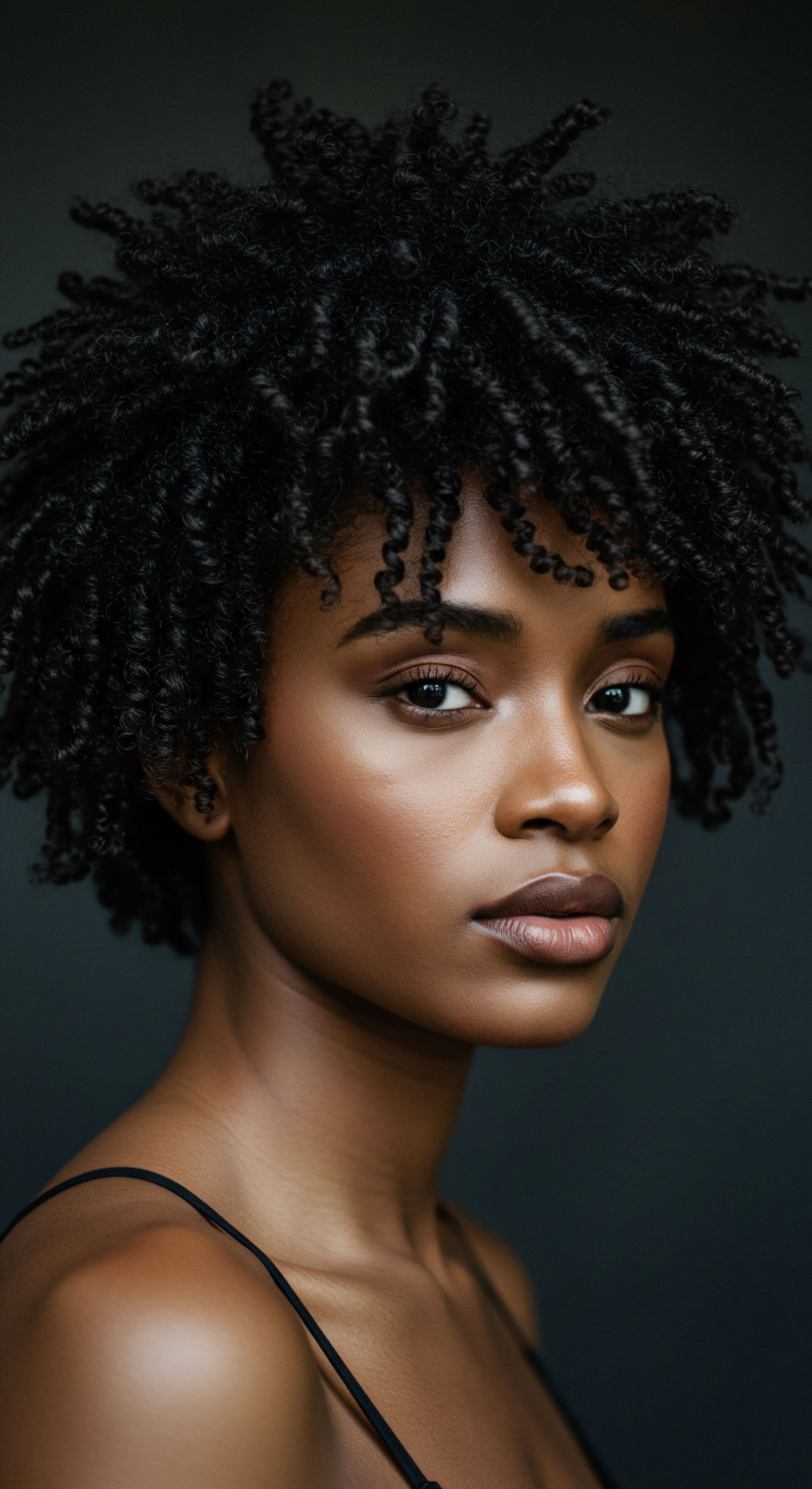
Roots
The strands that crown our heads, particularly those with a rich texture, hold stories—tales of heritage, personal expression, and daily care. Yet, beneath the surface of their strength and beauty, a silent, pervasive force often works to alter their very structure. This unseen adversary, environmental particulate matter, infiltrates our daily lives, touching everything from the air we breathe to the surfaces we touch.
For our hair, this interaction is far from benign. Understanding this connection begins with a journey to the very core of a single strand, exploring its delicate architecture and how external elements can disrupt its serene existence.
Our hair, whether tightly coiled, gently waved, or gracefully straight, shares a fundamental biological design. Each strand originates from a follicle nestled within the scalp, a living root that nourishes and shapes the hair as it grows. The visible portion, the hair shaft, is primarily composed of a resilient protein called keratin. This protein forms three distinct layers, each with a specific function.
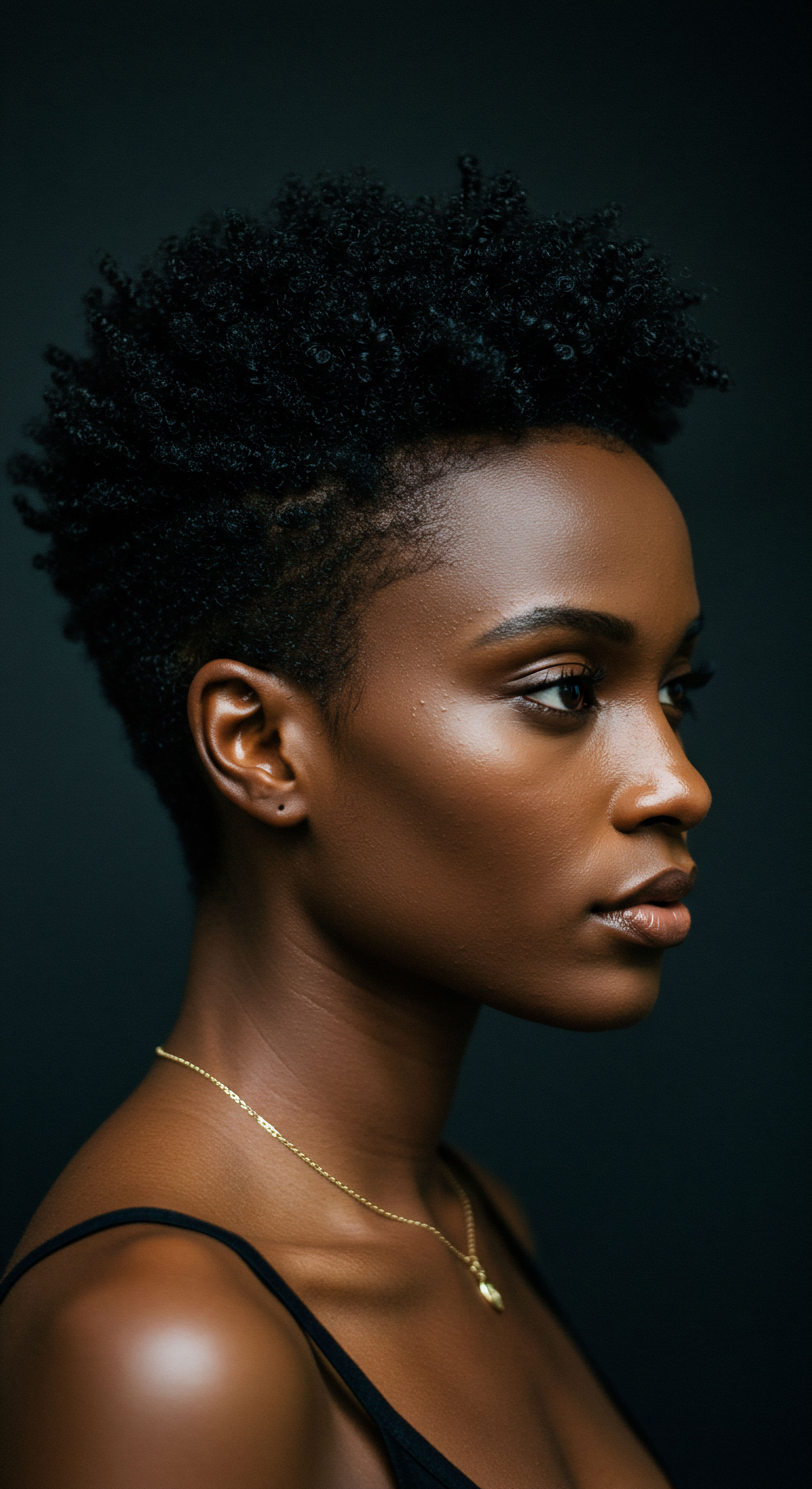
The Hair’s Protective Veil
The outermost layer, the Cuticle, resembles overlapping scales, much like shingles on a roof. These tiny, transparent cells lie flat, forming a protective barrier that shields the inner cortex from environmental stressors. A healthy cuticle reflects light, giving hair its natural sheen, and helps to seal in moisture, keeping the strand supple and pliable.
When this protective layer is compromised, the consequences become visible ❉ dullness, increased friction, and a propensity for damage. The cuticle’s integrity is a primary defense against the intrusion of foreign substances.
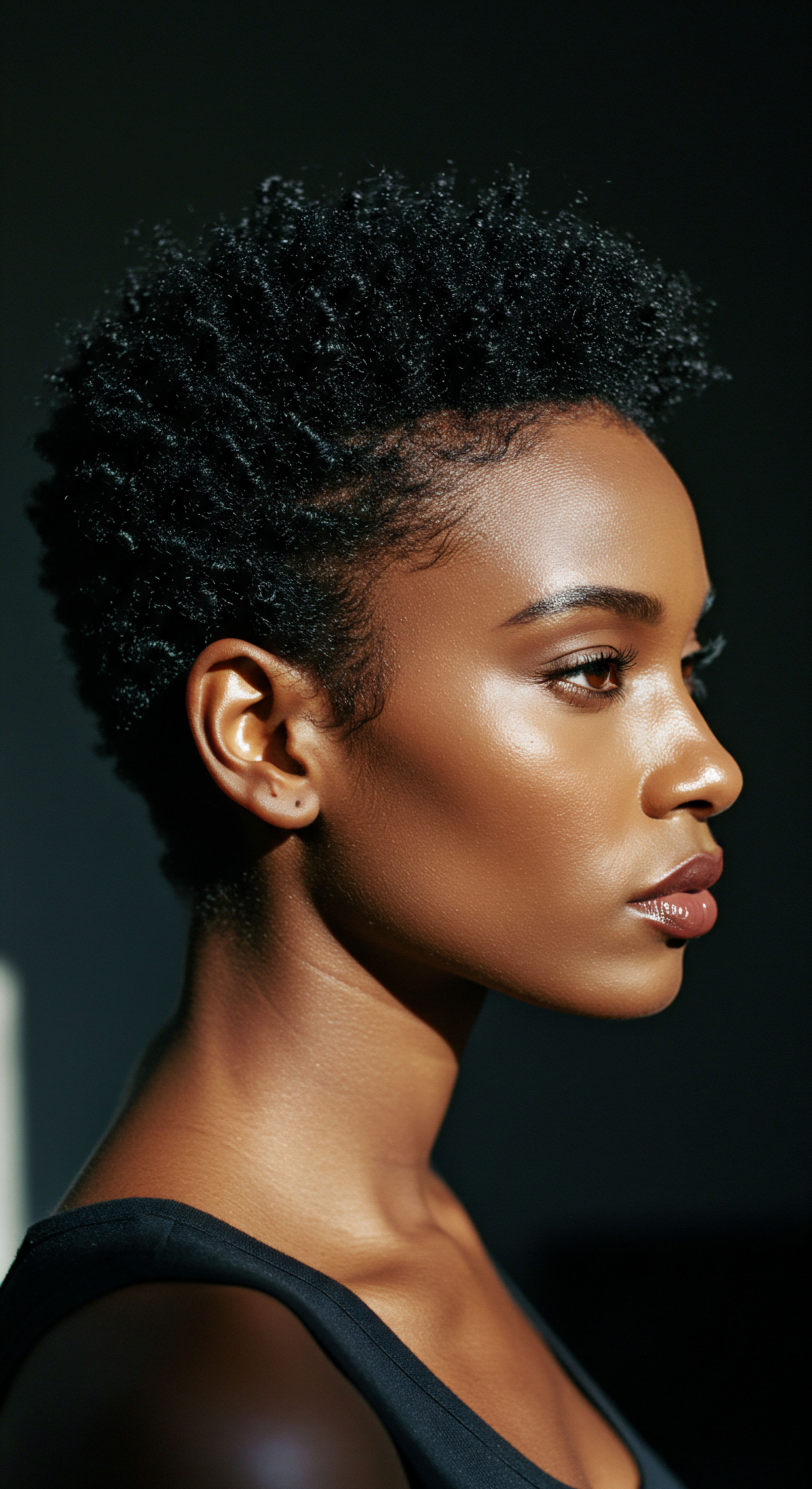
Porosity’s Silent Whispers
Beneath the cuticle resides the Cortex, the hair’s most substantial layer. This is where the majority of the hair’s keratin protein resides, along with melanin, the pigment that gives hair its unique color. The cortex is responsible for hair’s strength, elasticity, and overall structural integrity.
Any assault on the cortex can lead to weakened strands, increased breakage, and a loss of vitality. The innermost layer, the Medulla, a soft, central core, is not present in all hair types and its precise function is still being studied.
Hair’s porosity, a characteristic often discussed within textured hair communities, directly relates to the state of the cuticle. Hair with low porosity has tightly bound cuticles, making it resistant to moisture absorption but also more resilient against external penetration. High porosity hair, with its more open cuticle layers, readily absorbs moisture but also loses it quickly, rendering it more susceptible to environmental insults. Particulate matter finds an easier path into high porosity hair, potentially settling within the more open cuticle scales.
The hair’s outermost cuticle serves as a vital shield, and its condition dictates how readily environmental aggressors can compromise the strand’s integrity.

Growth Cycles and Environmental Echoes
Hair does not grow continuously; it follows a cyclical pattern with distinct phases ❉ anagen (growth), catagen (transition), and telogen (resting/shedding). Environmental factors, including particulate matter, can disrupt this delicate cycle. Prolonged exposure to pollutants can interfere with the signaling pathways that regulate hair follicle activity, potentially shortening the anagen phase and increasing the rate of shedding. This disruption can lead to noticeable thinning and a general reduction in hair density over time, affecting the very foundation of hair health.
The interaction between environmental particulate matter and hair begins at this fundamental level. These microscopic particles, often invisible to the naked eye, can settle on the hair shaft and scalp, initiating a cascade of reactions that compromise the hair’s natural defenses and structural components. Understanding these foundational elements of hair biology helps us grasp the profound impact of the unseen world around us.
| Hair Layer Cuticle |
| Primary Composition Overlapping keratin scales |
| Function Protective barrier, moisture retention, shine |
| Vulnerability to Particulate Matter Physical abrasion, lifting of scales, compromised barrier function, dullness. |
| Hair Layer Cortex |
| Primary Composition Keratin protein, melanin |
| Function Strength, elasticity, color |
| Vulnerability to Particulate Matter Protein degradation, oxidative stress, loss of strength, color changes. |
| Hair Layer Medulla |
| Primary Composition Soft, central core (not always present) |
| Function (Function still under study) |
| Vulnerability to Particulate Matter Less direct impact, but severe damage to cortex could indirectly affect. |
| Hair Layer Each layer contributes to hair health, and particulate matter can compromise these functions at various levels. |

Ritual
Our hair care rituals, often passed down through generations or discovered through personal experimentation, represent a deep connection to our strands. These practices, from gentle cleansing to protective styling, hold immense significance, not just for aesthetic appeal, but for maintaining the very vitality of our hair. As we navigate a world where unseen environmental elements pose constant challenges, these rituals take on an even greater purpose. They become our active response, our thoughtful approach to safeguarding our hair against the subtle yet persistent effects of particulate matter.
The urban environment, with its complex mixture of microscopic particles, presents a unique set of challenges for hair health. These particles, ranging from dust and soot to heavy metals and industrial emissions, do not simply rest on the hair’s surface. They can adhere, infiltrate, and initiate a chain of reactions that compromise the hair’s structure and overall well-being. This necessitates a thoughtful adjustment to our daily and weekly hair care practices.

Cleansing Rituals in Polluted Air
Regular and thorough cleansing becomes paramount in mitigating the effects of environmental particulate matter. These microscopic pollutants, particularly the smaller PM2.5 particles, can bind to the hair surface and infiltrate hair follicles, leading to irritation and damage. Simply rinsing with water may not be enough to dislodge these stubborn contaminants.
- Clarifying Shampoos ❉ Occasional use of clarifying shampoos can help remove accumulated particulate matter, heavy metals, and other residues that build up on the hair and scalp. These shampoos are formulated to deeply cleanse without stripping the hair of its natural moisture, particularly important for textured hair which tends to be drier.
- Gentle Daily Cleansers ❉ For more frequent washing, selecting gentle, sulfate-free cleansers helps to remove surface pollutants without causing excessive dryness or disturbing the scalp’s delicate balance. The goal is to purify the hair and scalp without compromising their natural defenses.
- Scalp Health Focus ❉ Since particulate matter can also irritate the scalp, leading to sensitivity, dryness, or excessive oiliness, incorporating scalp-specific cleansers or treatments can help address these concerns. A healthy scalp provides the best foundation for robust hair growth.

Protective Styles as Shields
Beyond cleansing, protective styling offers a physical barrier against environmental exposure. For textured hair, protective styles are not just about aesthetics; they are a long-standing tradition of safeguarding strands from manipulation and external elements.
Styles such as braids, twists, buns, and updos can significantly reduce the direct surface area of hair exposed to airborne pollutants. When hair is tucked away, it minimizes the opportunity for particulate matter to settle and adhere to individual strands. This physical shielding helps preserve the cuticle’s integrity and reduces the potential for oxidative stress caused by pollutant interaction.
Protective styles serve as a tangible defense, lessening direct exposure to environmental aggressors.

Nourishing Strands Against the Unseen
The assault of particulate matter often leads to oxidative stress, a process where unstable molecules called reactive oxygen species (ROS) damage cellular components, including hair proteins. To counteract this, our conditioning and moisturizing rituals must be fortified with ingredients that offer antioxidant benefits and help rebuild the hair’s structural integrity.
- Antioxidant-Rich Conditioners ❉ Look for conditioners and leave-in treatments containing antioxidants like Vitamin C, Vitamin E, and green tea extract. These ingredients can help neutralize free radicals generated by pollutants, reducing their damaging effects on hair proteins and melanin.
- Protein Treatments ❉ Regular protein treatments can help replenish the keratin lost due to environmental damage, restoring strength and elasticity to the hair shaft. However, balance is key; excessive protein can make hair brittle, so always follow with a moisturizing deep conditioner.
- Moisture Sealants ❉ Using heavier oils or butters as sealants, particularly for textured hair, can create an additional layer of protection, helping to prevent pollutants from settling directly on the hair shaft and sealing in much-needed moisture.
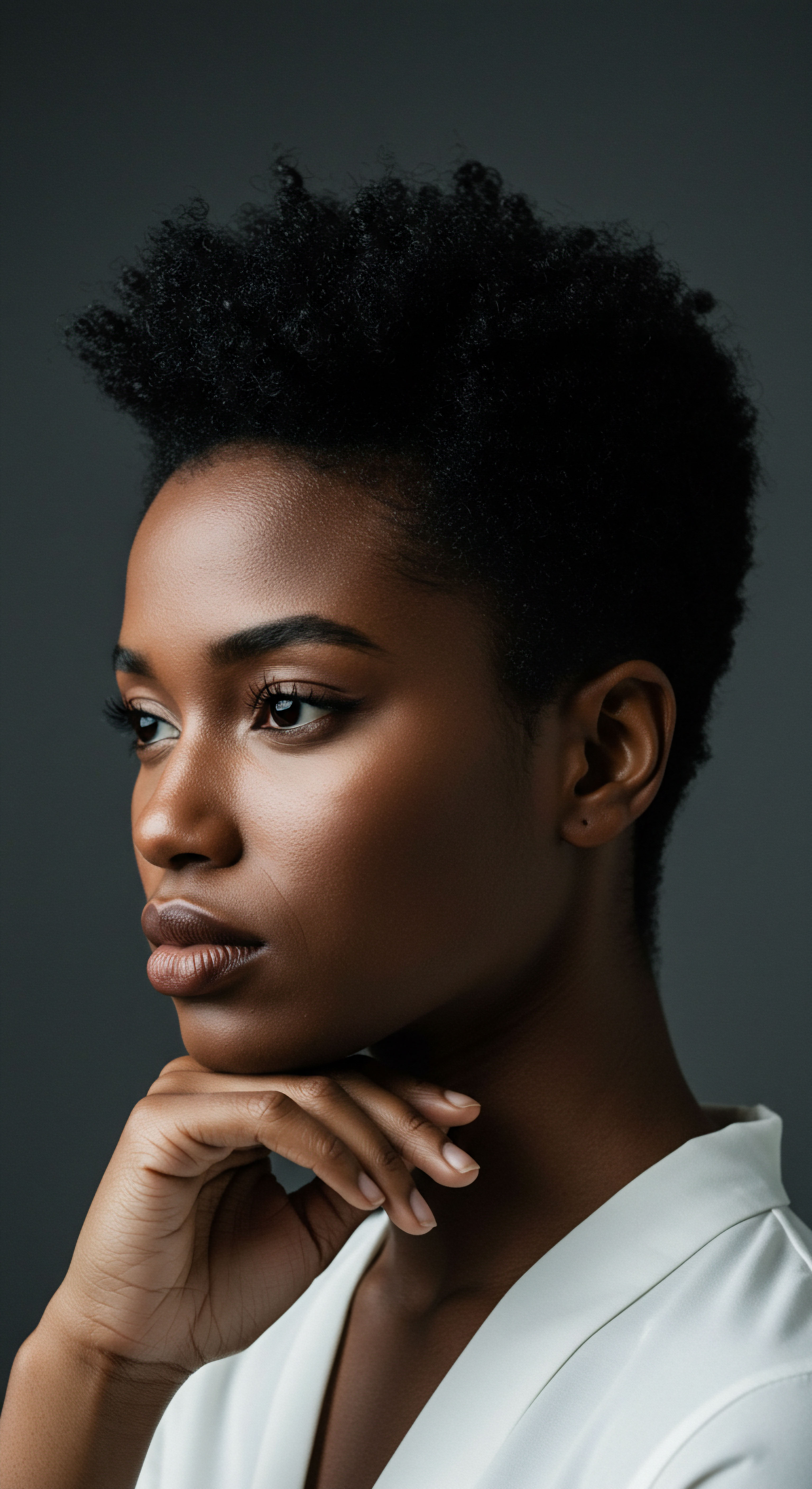
Beyond the Bonnet ❉ Nighttime Safeguards
The rituals extend beyond the waking hours. Nighttime care is a quiet, powerful act of restoration, allowing hair to recover from the day’s environmental exposures.
Wearing a Satin or Silk Bonnet or sleeping on a Satin or Silk Pillowcase is a well-established practice within textured hair care. These materials create a smooth, low-friction environment, preventing tangling, breakage, and moisture loss. In the context of pollution, this also means preventing any residual particulate matter that may have settled on hair during the day from transferring to bedding and potentially irritating the scalp or being re-agitated into the air around you while you sleep. This simple yet profound practice contributes to overall hair health and resilience against environmental stressors.
| Care Category Cleansing |
| Traditional Practice Regular shampooing |
| Pollution-Conscious Adjustment Occasional clarifying, gentle daily cleansers, scalp-focused purification. |
| Care Category Protection |
| Traditional Practice Styling for appearance |
| Pollution-Conscious Adjustment Strategic use of protective styles to minimize direct exposure. |
| Care Category Nourishment |
| Traditional Practice Conditioning |
| Pollution-Conscious Adjustment Antioxidant-rich products, balanced protein treatments, effective moisture sealants. |
| Care Category Nighttime Care |
| Traditional Practice Sleeping |
| Pollution-Conscious Adjustment Satin/silk bonnets or pillowcases for reduced friction and contaminant transfer. |
| Care Category Adapting care practices helps mitigate the cumulative effects of environmental particulate matter. |
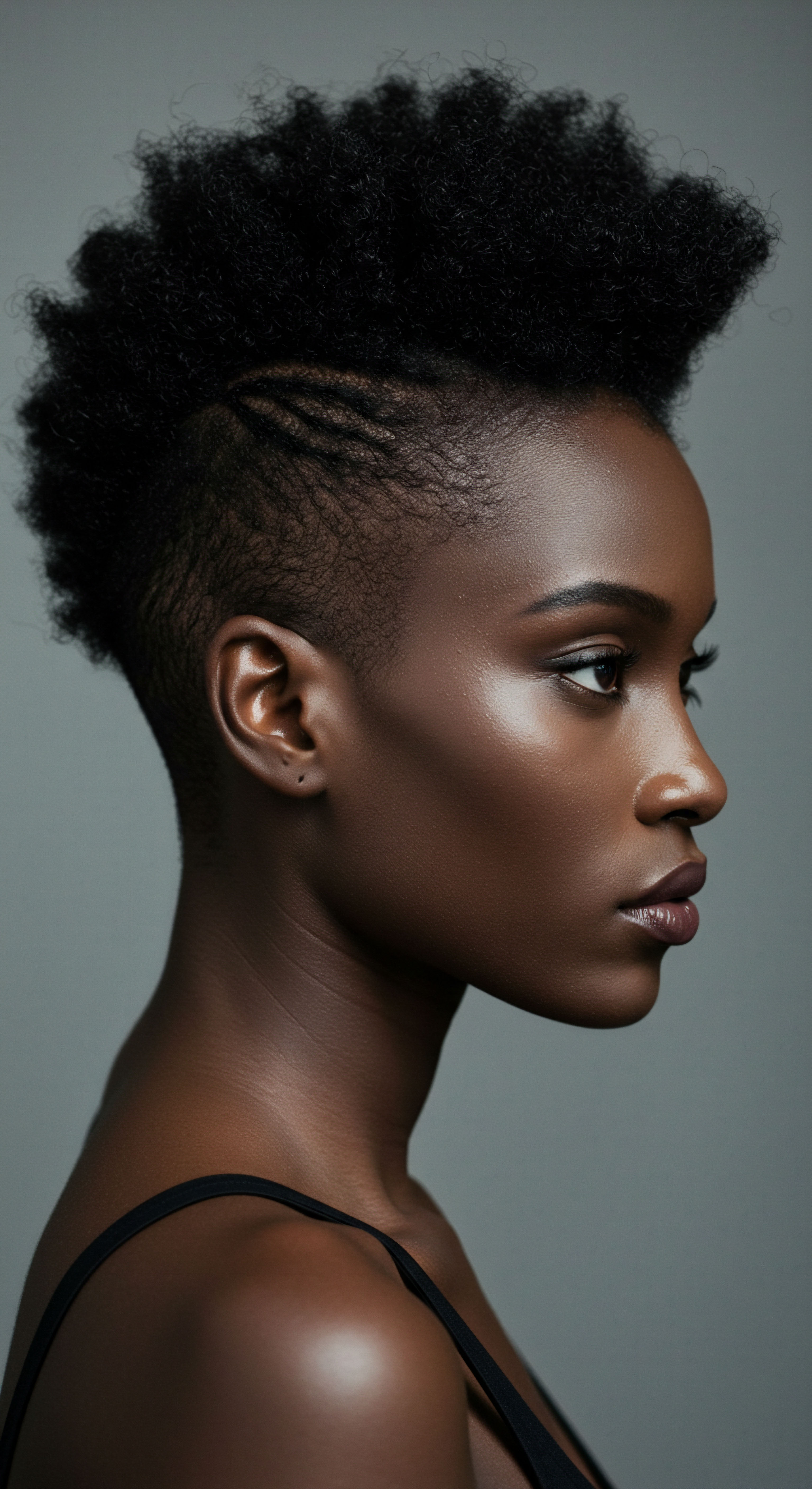
Relay
Beyond the visible alterations and the daily routines, the relationship between environmental particulate matter and hair damage stretches into a realm of intricate biological processes and broader societal considerations. It is a story not just of superficial change, but of profound cellular responses and a complex interplay of environmental factors that demand a deeper, more scientific inquiry. How do these microscopic elements truly interact with our hair at its most fundamental level, and what does this mean for textured hair, often uniquely positioned within these environmental narratives?
The air we breathe, particularly in urban and industrial zones, carries a silent burden of particulate matter (PM). These are not homogenous entities; they comprise a diverse collection of solid particles and liquid droplets, varying significantly in size and chemical composition. The most concerning are PM2.5 (particles with a diameter of 2.5 micrometers or smaller) and Ultrafine Particles (even smaller, capable of deeper penetration). These minute fragments can carry adsorbed polycyclic aromatic hydrocarbons (PAHs), heavy metals, and other toxic compounds, transforming them into potent delivery systems for harm.

Unmasking the Microscopic Adversaries
The true impact of particulate matter lies in its ability to initiate a cascade of detrimental cellular and molecular events. When these particles settle on the hair and scalp, they do more than just make hair feel dirty; they actively disrupt biological equilibrium.
- Oxidative Stress ❉ This is perhaps the most significant mechanism of damage. Particulate matter, especially when combined with UV radiation, generates reactive oxygen species (ROS). These highly reactive molecules attack cellular components, including lipids, proteins, and DNA within hair follicles and the hair shaft. This oxidative assault degrades keratin, the very building block of hair, compromising its strength, elasticity, and overall integrity.
- Protein Carbonylation ❉ A specific form of oxidative damage, protein carbonylation, leads to irreversible modification of hair proteins. Research indicates that urban pollutants, including particulate matter, induce this carbonylation, particularly affecting keratins and keratin-associated proteins. This irreversible alteration contributes directly to hair damage.
- Inflammation ❉ Prolonged exposure to pollutants can trigger an inflammatory response in the scalp. This inflammation can disrupt the normal function of hair follicles, leading to conditions such as folliculitis, seborrheic scalpitis, and even hair loss. The scalp, acting as a primary barrier, experiences significant stress from these environmental aggressors.
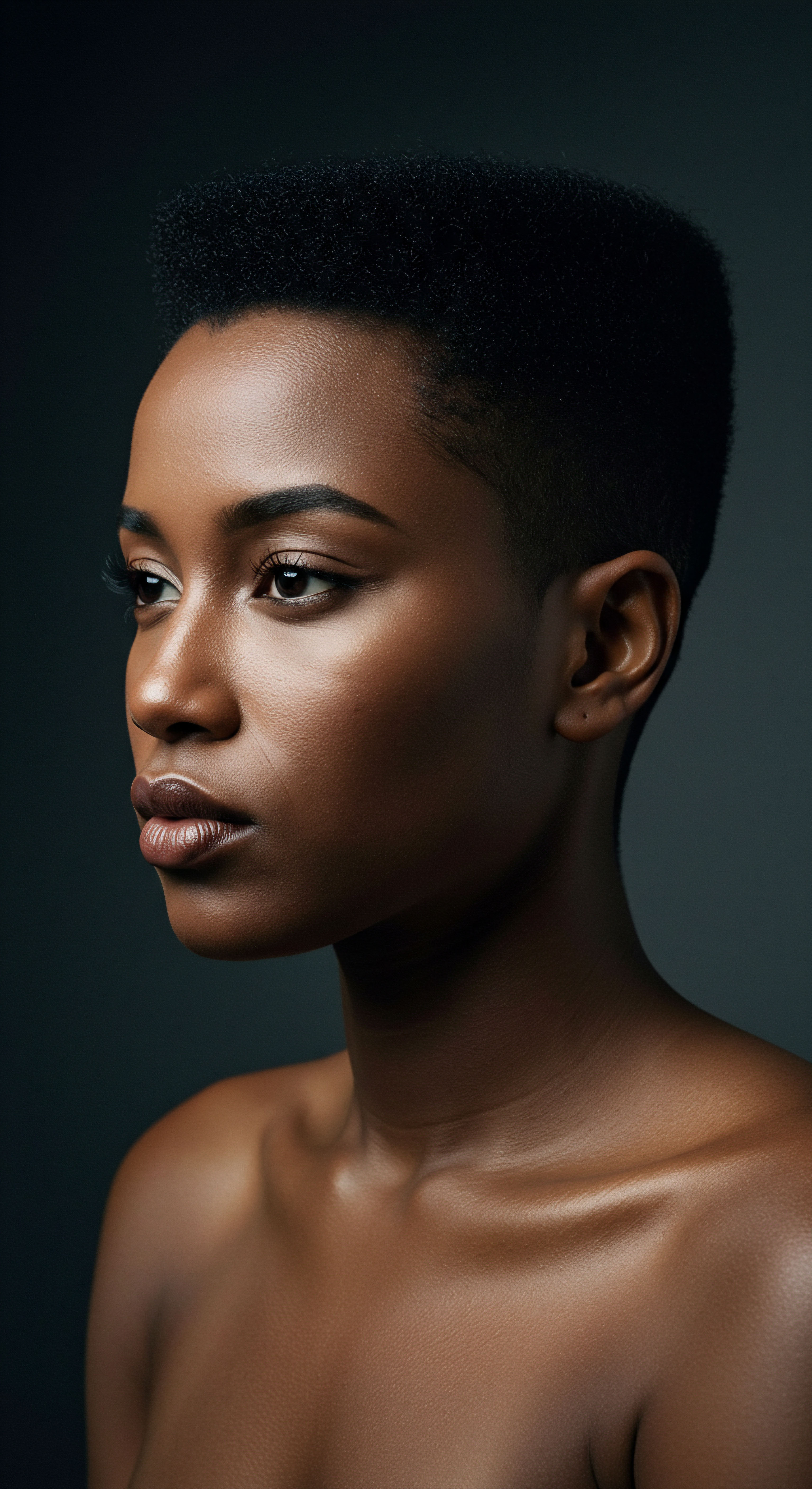
The Chemical Dance of Damage
The chemical components carried by particulate matter contribute directly to hair degradation. Polycyclic aromatic hydrocarbons (PAHs), often byproducts of combustion, adhere to the hair surface and can penetrate the hair fiber, causing chemical damage to the cuticle and internal proteins. Heavy metals like lead, mercury, and cadmium, also present in polluted air, can accumulate on the scalp and within hair follicles, impairing their function and potentially leading to premature hair loss and changes in pigmentation.

Hair’s Unseen Burden ❉ A Case Study
Hair serves as a remarkable bioindicator of environmental exposure, silently recording the story of our interaction with the atmosphere. Its unique structure allows pollutants to accumulate within its matrix over time, providing a long-term record of exposure that other biological fluids cannot.
A compelling study conducted in Milan, Italy, between July 2007 and April 2008, offers a powerful illustration of this phenomenon. Scalp analyses performed on approximately 300 volunteers revealed that the concentration of fine particulate matter and heavy metals deposited in the hair was 1.5 times higher than in the air itself. Even more striking, the amount deposited on the scalp was twice as high as in the air.
This data underscores the profound accumulation of environmental pollutants on hair and scalp, highlighting their role as a significant reservoir for these harmful substances. The study provides concrete evidence that our hair and scalp are not merely passive recipients of environmental pollution but active sites of accumulation, making them particularly vulnerable to the associated damage.
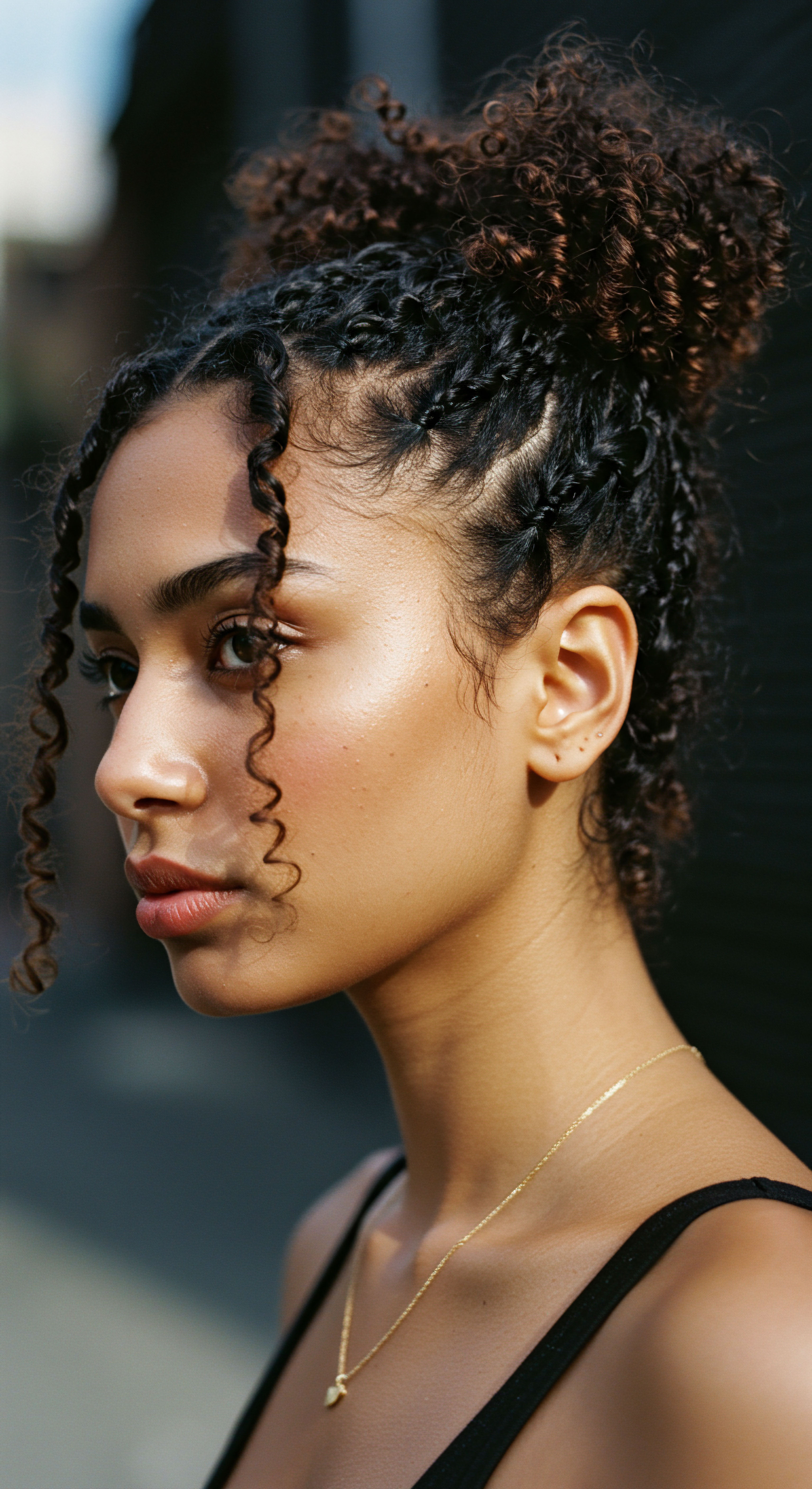
Scalp’s Silent Struggle
The scalp, with its rich network of hair follicles and sebaceous glands, is a critical battleground against particulate matter. The skin’s lipid layer acts as a natural barrier, yet pollutants can alter its composition, diminishing its protective capabilities. PM can penetrate hair follicles, and even if larger particles do not fully permeate the skin barrier, their soluble components can release harmful substances, causing irritation and inflammation.
A South Korean cosmetics company’s research, presented at the 28th European Academy of Dermatology and Venereology (EADV) Congress, provided further evidence of this deep impact. Their findings indicated that air pollutants, specifically PM10-like particles from dust and diesel, significantly reduced the levels of key proteins vital for hair growth, including Beta-Catenin, Cyclin D1, Cyclin E, and CDK2. These proteins are crucial for hair follicle activity and morphogenesis, suggesting a direct link between particulate matter exposure and impaired hair growth cycles, potentially leading to hair thinning and loss.
Hair serves as a powerful bioindicator, accumulating environmental pollutants at concentrations higher than ambient air, reflecting a continuous exposure.

Hair’s Resilience Across Continents
The conversation around hair health and environmental pollution extends beyond individual biology to broader societal contexts. Environmental justice, for instance, highlights how communities of color and low-wealth communities are often disproportionately exposed to higher levels of air pollution due to systemic inequities in urban planning and industrial siting. This heightened exposure can translate to a greater burden of hair and scalp issues, adding another layer of complexity to the pursuit of hair wellness.
Consider the implications for textured hair within this context. The structural differences in textured hair, such as its varied porosity and curl patterns, might influence how particulate matter adheres and how deeply it penetrates. While research specifically on PM’s differentiated impact across hair textures is still growing, the general mechanisms of oxidative stress and protein degradation apply universally. The compounding factor of disproportionate environmental exposure for certain communities makes understanding these mechanisms even more pressing.
| Hair Component Hair Proteins (Keratin) |
| Mechanism of Damage Oxidative stress, protein carbonylation, direct chemical attack. |
| Observed Effects Degradation, weakening, loss of strength, increased breakage. |
| Hair Component Hair Follicles |
| Mechanism of Damage Inflammation, apoptosis of keratinocytes, disruption of growth proteins. |
| Observed Effects Impaired hair growth, thinning, hair loss, scalp sensitivity. |
| Hair Component Melanin (Hair Pigment) |
| Mechanism of Damage Oxidative stress, heavy metal accumulation. |
| Observed Effects Premature graying, color changes. |
| Hair Component Scalp Lipid Barrier |
| Mechanism of Damage Alteration of composition, irritation, inflammation. |
| Observed Effects Dryness, oiliness, itching, dandruff, weakened barrier function. |
| Hair Component Particulate matter influences hair health at microscopic and macroscopic levels. |

Reflection
The silent presence of environmental particulate matter casts a long shadow over the vitality of our hair. From the intricate cellular mechanisms within the follicle to the visible changes in strand texture and resilience, the influence is undeniable. Our hair, a living expression of self and heritage, carries the imprints of the air it encounters. This journey into its vulnerability is not meant to evoke concern, but rather to invite a deeper awareness and a gentle call to action.
By understanding the subtle dance between our strands and the microscopic world around us, we gain a renewed sense of purpose in our care practices. Each mindful cleanse, each protective style, and every nourishing ritual becomes a testament to our commitment to hair wellness, a quiet rebellion against the unseen forces that seek to diminish its strength and radiance. Our hair, after all, is a beautiful, resilient part of us, deserving of our most thoughtful attention in a world that asks much of it.

References
- Choi, S. et al. (2019). “Particulate Matters Induce Apoptosis in Human Hair Follicular Keratinocytes.” Toxicology Letters, 312, 178-185.
- Drakaki, E. Dessinioti, C. & Antoniou, C. V. (2014). “Air Pollution and the Skin.” Frontiers in Environmental Science, 2.
- Galliano, M. et al. (2015). “Evaluation of the Impact of Urban Pollution on the Quality of Skin ❉ A Multicentre Study in Mexico.” International Journal of Cosmetic Science, 37(3), 329-338.
- Jeon, S. et al. (2024). “The Invisible Threat to Hair and Scalp from Air Pollution.” Polish Journal of Environmental Studies, 33(4).
- Mancebo, S. E. & Wang, S. Q. (2015). “Recognizing the Impact of Ambient Air Pollution on Skin Health.” Journal of the European Academy of Dermatology and Venereology, 29(12), 2326-2332.
- Naudin, G. et al. (2019). “Human Pollution Exposure Correlates with Accelerated Ultrastructural Degradation of Hair Fibers.” Proceedings of the National Academy of Sciences, 116(37), 18342-18347.
- Qu, L. et al. (2018). “Pollution Damage and Protection of Asian Hair.” Cosmetics, 5(1), 13.
- Rajput, R. (2015). “Understanding Hair Loss due to Air Pollution and the Approach to Management.” Hair Therapy & Transplant, 5(1), 133.
- Seinfeld, J. H. & Pankow, J. F. (2003). “Organic Atmospheric Particulate Material.” Annual Review of Physical Chemistry, 54(1), 121-141.
- Tiwari, S. et al. (2024). “The Effects of Environmental Pollutants and Exposures on Hair Follicle Pathophysiology.” International Journal of Trichology, 16(2), 57-67.